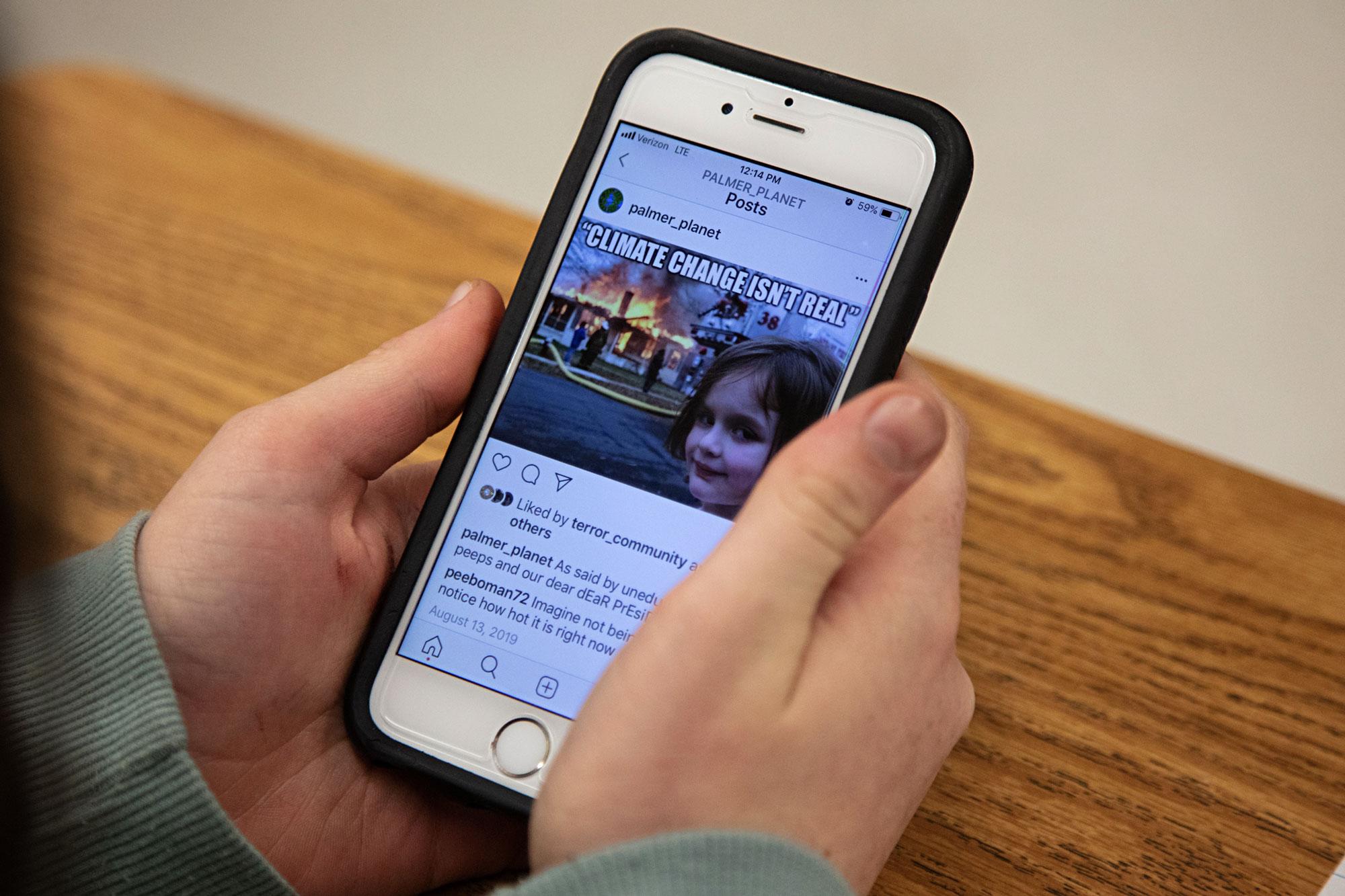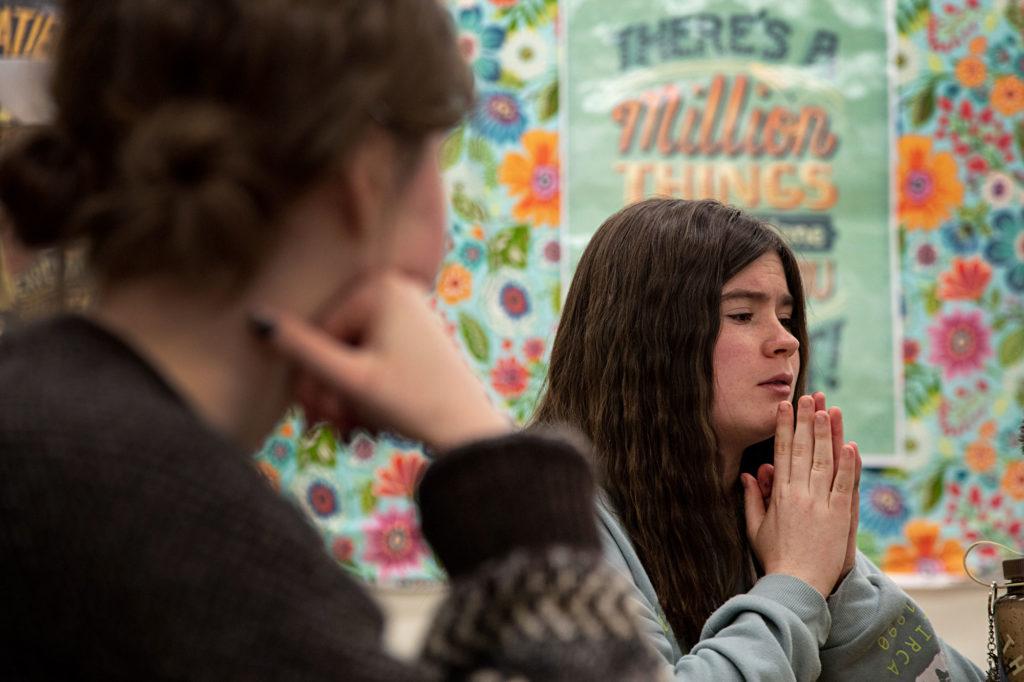
Once a week at lunch hour, Palmer High School’s Climate Club gets together to talk big ideas. Sophomore Taylor Saulsbury leads the group of Colorado Springs students on climate strike plans, and thoughts on how to get plastic utensils out of the cafeteria.
“I think it's become a major part of my life,“ Taylor said. “It's sad, and it's also empowering at the same time.”
Taylor started the school’s climate club after feeling depressed about climate change. But before she started the club, she made an Instagram account. It’s called Palmer Planet. Taylor has made and shared memes, “to get at [her] generation.”

“This is how we talk about issues in the most non-offending way,” Taylor said.
Memes often make light of serious topics. Coronavirus. War. School shootings. If you spend any time on the internet at all, you’ve encountered a meme. A well-known meme-style is an image, captioned with different jokes— likely in bold, white lettering.
One example is “Disaster Girl.” It’s a closeup photo of a young girl looking right at the camera, with a slight grin on her face. Behind her, there is a house on fire. And the little girl looks pleased.
Taylor used the meme to make a point. She captioned the image, “Climate change isn't real.”
Sophomore Roxy Houck is also part of Palmer High’s climate club. She says that memes help get the word out on the issue. They also help her find humor in situations that can otherwise seem frightening.
“It’s definitely coping,” Roxy said. “It's seeing that like, it's not just me. Or it's not just the people I know. It's like almost all the teenagers I know, know about it and are worried about it.”
Teens like Roxy and Taylor see environment memes as a way to help them have conversations about something that’s otherwise tough to talk about. And if teens can talk about climate change — online or off — the two hope it means they might want to do something about it.
Matt Schimkowitz is the senior editor at Know Your Meme. The site started in 2008, it researches and documents internet memes and viral phenomena. Over the years, it’s developed into a massive Wiki that “helps to document the internet in real time,” Schimkowitz said.
Schimkowitz said climate and environment-themed memes spike in popularity with teens around big events, like the Australian Bushfires.
“There's a lot of gallows humor about it. It's a lot of jokes about how there isn't going to be a planet for them to grow old into, which is obviously very sad,” Schimkowitz said.
He thinks the memes reflect a feeling of desperation, but believes it’s a “defense mechanism, to kind of actually express concern about these things, and spread these ideas farther.”
Ivan Tochimani-Hernandez is a senior at DSST: Montview High in Denver. He’s part of the school's “Green Team.” It was started by a group of students after they learned more about failing environmental health through science class.
Ivan immigrated from Mexico, because he said the pollution there was too much for his health issues. He said the internet gives kids a voice, especially since they can’t vote.
“Connecting with others from others, schools, other states, other countries. It's an amazing feeling to have,” Ivan said.
He thinks memes and social media can be a source of hope. There are jokes about loving plants too much, or people making fun of themselves for how passionate they are about reusable straws. Ivan is inspired by 17-year-old Swedish climate activist Greta Thunberg, who has almost 10 million followers on Instagram.
“If somebody so young and so talented could bring a global change, it makes me hopeful for the future,” Ivan said.
Senior Luke Bowen is on the Green Team with Ivan. One thing disheartens him about discussing climate change through social media — it can seem like a trend.
“Like even Greta, like sometimes she's super big and then she kinda like fades away again. Like anything that goes like trends, which is kind of unfortunate,” Luke said.
Fellow senior and Green Team member Natalie Smink thinks those trends demonstrate how climate change is a global issue. When she posts things on the Green Team’s social accounts, she uses the hashtag #GlobalClimateStrike. That way, people from all over the world see it.
“You could see a post from someone in Europe, striking at the same time as someone in the U.S,” Natalie said. “It does make it kind of a trend where it will disappear, but it gives that unity to begin with. And I think that's what the world really needs.”
These memes don’t just live online. You can see them printed out on picket signs and posters, when teens go on climate strikes. Dagoberto Grijalva, another senior on the Green Team, points out why he thinks millions have turned out to those protests.
“It was social media that did that. And if social media can organize things such as that, like just imagine what more it could create,” Grijalva said.
For these students at Palmer and Montview High, climate memes are no joke. They create an online community of young people concerned about their future, and their collective voice has sparked a movement of youth-led climate activism.








